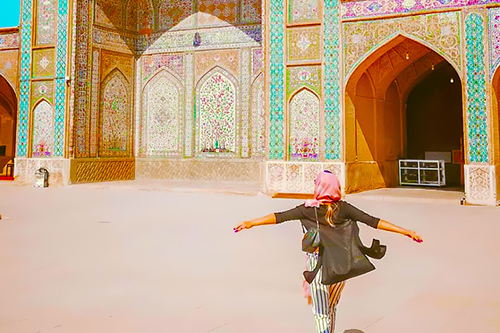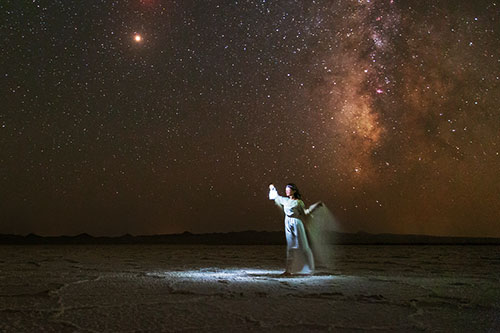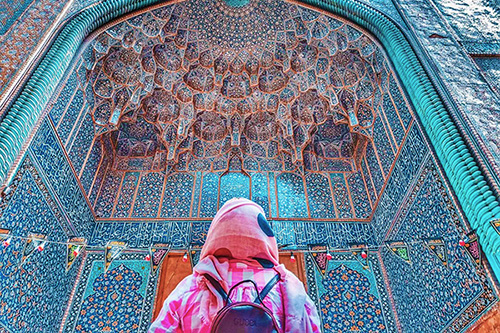 Signin with Google
Signin with Google Signin with Facebook
Signin with Facebook About Iran
About IranDeserts of Iran, a Leading List of Undeniable locations
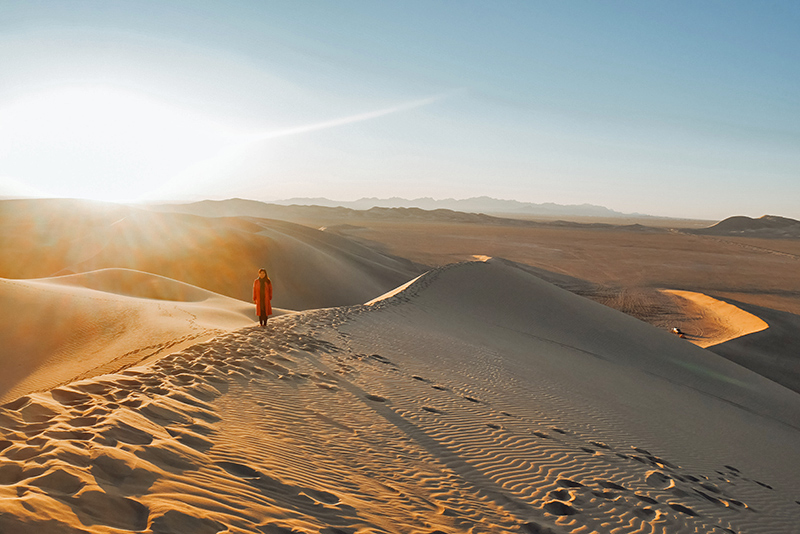
Deserts are enigmatic landscapes bewildering every visitor with their mystery, and Iran is a rich country in terms of having exceptional deserts. About one-third of Iran's area is covered with untamed desert landscapes. Whether you enjoy tranquillity, seek a picturesque spot to watch the sunset, long for an exciting safari or camping under the starry sky, various tastes of travellers would be fulfilled in Iran desserts. Travelling to Iran in autumn or winter between October to March provides a great chance to adventuring these magnificent natural beauties. Let's keep tuned to learn about the top desert scenery spots in Iran.
1. Dasht-e Kavir, the largest salt desert in Iran
Covering almost 77,600 km², Dasht-e Kavir is surrounded by Alborz and Zagros Mountain Ranges, the main two ranges of the Alpino passing through the Iranian Plateau. There are several seasonal lakes and marshlands created by the rains' runoff in this desert.
This little rain and snow provide a living condition for rare shrubs and plants and animals like Persian leopards, gazelles, goats and so on. Kavir National Park, Sirjan Salt Swamp, Houz-e Soltan Salt Lake, and Houz-e Ghilooghe are some natural attractions in the Dasht-e Kavir.
2. Lut, the spell of infinite gravel land
One of the world's immortal attractions covering almost 10% of Iran is named Lut meaning bare and lifeless. However, it is the real land of immortality. Lut owns the second-largest Iranian desert title after Dasht-e Kavir Desert and Iran's first Natural World Heritage of UNESCO.
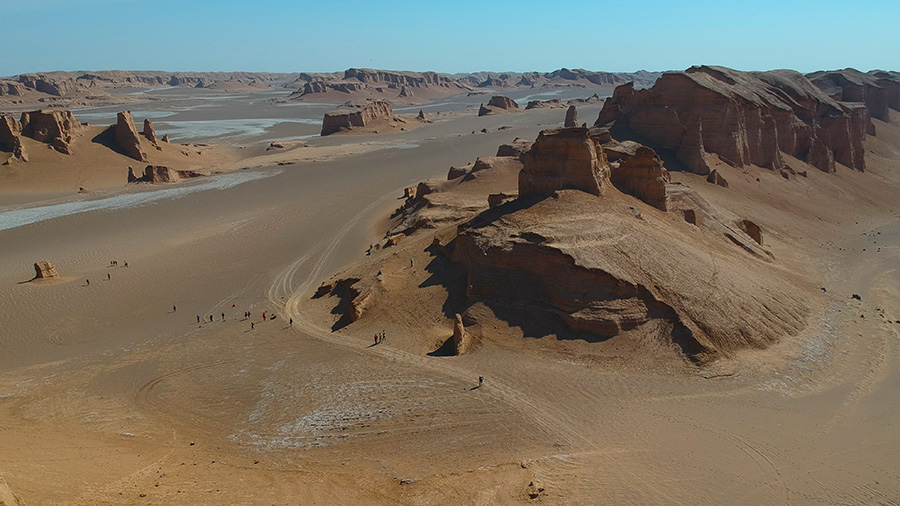
According to the NASA satellite, the highest temperature on the globe is registered in Lut, reaching a world record of 70.7 degrees Celsius; nevertheless, the vibrant ecosystem is living in this harsh condition. Exceptional Aeolian yardang formations or Kaluts, large sand vases, salt lake, black volcano lava and imposing sand dunes are some of the marvellous geological attractions of Lut to visit. The best time to visit the magic land of Lut is from April to May and fall.
3. Shahdad, the ancient city of sandy skyscrapers
Shahdad Desert is a fascinating area in the Northeast of Lut Dessert, in Kerman Province. Twenty thousand years of permanent erosion made a unique phenomenon in Shahdad, Kaluts. The gigantic and strange sandy sculptures and protuberances, scientifically named Yardang, made this part of Iran like a fictional film scene. Erected up to 200 meters, these sandy skyscrapers continuously change their shapes with every touch of the wind. The signs of a ghost city in Shahdad prove an ancient geological pole on the skirts of Lut.
4. Touch the sky in the Mesr Desert
Mesr is a village and one of the most famous deserts near Khor va Biyabank City in Isfahan Province. This extensive desert is a favourite destination for ecotourists. Fine ecolodges and clean hostels give you this extraordinary chance to stay a few days in the Mesr Desert and enjoy every minute of this new experience. Walking barefoot over the sand dunes, watching the shiny sands reflecting the last breath of sunlight, enjoying the marvellous view of the sunset, finding yourself under the mesmerizing spell of moonrise. Seating around a campfire, it seems easy to reach out your hand and touch the stars. Here you can also try camel riding, off-road SUVs or ATV motors.
The largest seasonal salt lake in Iran, Khur, is in this area. The oldest salt extracted in Iran was from this lake. The bottom of this lake is covered with salty geometric forms.

5. Camping in the Maranjab Desert, once in a lifetime experience
Driving just three hours away from Tehran, Maranjab Desert is located near Kashan City, in Isfahan Province. Safety, accessibility and several natural and historical attractions made Maranjab a popular destination. Once a resting place along the Silk Road, Maranjab still is a touristic spot in the middle of Iran. Padding the golden sand dunes, enjoying stunning sceneries of sand runes, staying a night in the old Abbasi Caravanserai,and seeing special vegetation like Tamarix or Haloxylon bushes and rare animals are the charms of Maranjab.
On the west of the Maranjab desert, another natural attraction is situated. Houz-e Sultan Salt Lake, gets an attractive reddish hue during a few days of the year. The Jazire Sargardan (wandering island), an island surrounded by a sea of salts is another magnificent attraction of this desert. After rains, the water surrounding this island makes this hallucination of a floating island in the middle of the water.

6. Zardgah, a green desert!
Near Tabas city in the South Khorasan Province, on the foothills of Mount Nayband, the lesser-known Zardgan desert is situated.
Wide green palm groves and citrus trees of the nearby village made a different view of deserts in Iran. This green spot is completely different from other arid deserts. Besides the pleasant gardens, the hot springs and a small pool magnify the joy of visiting Zardgah.
7. Matin Abad, a desert campus and resort
If you are enthusiastic about deserting, but you are not an expert in enduring it, Matin Abad Eco-camp is a good place to have this life lasting experience.
This touristic area near Natanz in Isfahan Province provides modern facilities to experience desert related activities. Located among vast sand dunes and grass-covered plains, you can enjoy camel riding, sand padding, biking, and star observation. You could also stay a few days in tents or suites and visit nearby organic farms, and horse or ostrich breeding sites. Matin Abad was recognized as one of the world's best ecotourism resorts in 2014.

8. Abouzaid Abad Desert and the world's largest underground city
Abouziad Abad or Zidabad desert is in the northeast of Kashan. Besides the chance of adventuring and having those amazing experiences of deserting in parts of Dasht-e Kavir, for its unique location you can visit several worthy historical monuments. Fascinating Abyaneh stepped village, 400-year-old Safavid Caravanserai, and Noushabad Underground City are some of them.
Ouyi or Noushabad Underground City is recognized as the largest underground city on the globe. This unique structure probably was a refuge with a flawless ventilation system so that people could survive during invasions and attacks. People built this stunning city in the Sassanian era with bare hands. It was used until the Qajar era, about 1200 years. Dug in 18 meters with four underground levels, vertical channels connect these floors. For air ventilation and entrance, some vertical passages have been constructed. Ouyi City is a labyrinth of chambers, corridors, and wells giving each family their exclusive spaces. Specific places for food and water supplies or toilets were also designed in this city.

9. Rig-e Jenn, a hunted desert ?!
In the southwestern Dasht-e Kavir a strange area of sand dunes is situated. Locals believe that jinns and ghosts are created and inhabited here. A strange sound is always heard in Rig-e Jenn. Though it is the sound of stones cracking due to the constant temperature variation day & night, locals called it the Cry of Stones.
Rig-e Jenn is the most enigmatic desert in Iran not only for the jinns' stories but also for its strange and dangerous marshes. Like the Bermuda Triangle, the sandy swamp swallows everything downward. Putting all these fictions asides, you should put Rig-e Jenn on your itinerary to enjoy the marvellous desert sky, try the exciting off-road activities, or feel the hot sleepy sands under your foot.
It is better not to travel alone in this region and follow those nature trekkers who are familiar with Rig-e Jenn.
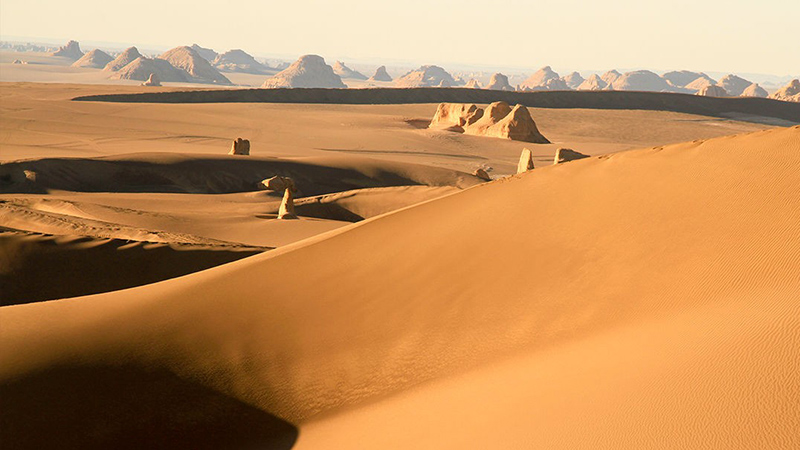
10. Lost paradise in the heart of Helwan Desert
One of Iran's most beautiful deserts is just near the largest city of Iran, Tabas, in the South Khorasan Province. Helwan Desert got its name from a nearby village. With large palm groves and lemon or orange gardens, Helwan is a unique oasis in the heart of the desert providing a completely new experience of deserting.
Just imagine enjoying the pleasant weather and eye-pleasing view of a green landscape after a nice walk on the sand dunes! There is also a prehistoric cave near the village dating back to the Middle Jurassic era. The cave is covered with wonderful sand marshes and salt plains.

Deserting in the deserts of Iran, it is better to have some points in mind:
• Have more food and water than you need
• Have a napkin or scarf to cover your head in case of exposure to a sand storm
• Respect the wildlife and remember that these desert inhabitants are harmless unless they are provoked
By Samaneh Zohrabi / TasteIran
